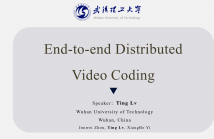
DCC 2022 Conference - The Data Compression Conference (DCC) is an international forum for current work on data compression and related applications. Both theoretical and experimental work are of interest. Visit the DCC 2022 website.
- Read more about Burrows-Wheeler Transform on Purely Morphic Words
- 3 comments
- Log in to post comments
- Categories:
 78 Views
78 Views
- Read more about x3: Lossless Data Compressor
- Log in to post comments
x3 is a lossless optimizing dictionary-based data compressor. The algorithm uses a combination of a dictionary, context modeling, and arithmetic coding. Optimization adds the ability to find the most appropriate parameters for each file. Even without optimization, x3 can compress data with a compression ratio comparable to the best dictionary compression methods like LZMA, zstd, or Brotli.
slides.pdf
- Categories:
 57 Views
57 Views
- Read more about Entropy Modeling via Gaussian Process Regression for Learned Image Compression
- Log in to post comments
- Categories:
 38 Views
38 Views
Block-based compressive imaging enables new video acquisition methodology while reducing raw data size, theoretically eliminating the need for complex coding algorithms. When transmitting raw data, however, the redundancy associated with random projection remains. This paper takes a fresh look at raw data structure by viewing it as cube made up of multiple downsampled images rather than a vector. As a result, we can view each individual data point as a pixel, allowing us to code more flexibly and versatility than state-of-the-art works.
- Categories:
 46 Views
46 Views
- Read more about Contact Matrix Compressor
- 2 comments
- Log in to post comments
The study of three-dimensional folding of chromosomes is important to understand genomics processes. This is done through techniques, such as Hi-C, that analyze the spatial organization of chromosomes in a cell. The data coming from the study is a 2-dimensional quantitative maps with genomic coordinate systems. We present a novel approach called Contact Matrix Compressor(CMC) for the efficient compression of Hi-C data. By exploiting the properties of the data, such as diagonally dominant and symmetrical, CMC achieves a much higher compression.
- Categories:
 40 Views
40 Views
- Read more about Privacy-Assured and Multi-Prior Recovered Compressed Sensing for Image Compression-Encryption Applications
- Log in to post comments
Compressed sensing (CS), a popular signal processing technique, can achieve compression and encryption simultaneously. Therefore, it has extension applications in various fields. However, CS is vulnerable to cryptographic attacks for its linear encoding process. To solve this problem, a permutation-diffusion structure is designed and embedded to the CS encoding process. In addition, it can increase the key space while compressing. Since the permutation-diffusion structure reduces the sparseness, superior recovery performance cannot be achieved.
- Categories:
 35 Views
35 Views

- Read more about Rate Distortion Characteristic Modeling for Neural Image Compression
- Log in to post comments
- Categories:
 27 Views
27 Views